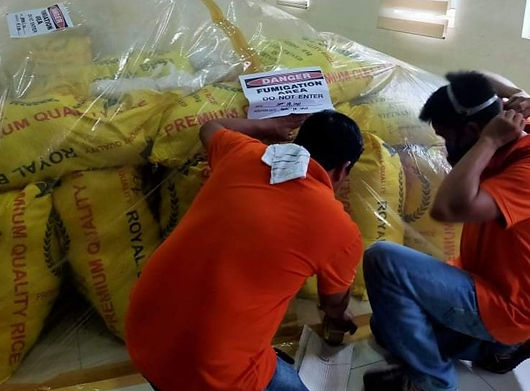Fumigation Service
In many warehouses, food commodities such as rice, corn, grains, cereals, flours and spices are stored for a long period. Cross infestation is likely to occur when destructive and harmful pests such as weevils or beetles from poor quality commodities can infest other food products. Fumigation treatment is engaged periodically to protect your commodities from these problems. Stored products e.g. cereals, seeds, herbs, etc. are often infested by a wide range of stored product pests. Experience from across the world has shown that using phosphine products for stored products treatment to control pests is effective.

Efficacy of fumigation treatment
Phosphine fumigation has been found to be effective in many countries worldwide. Phosphine fumigation is an effective method of eliminating insects in stored commodities. Fumigation of stored products with phosphine products as prescribed by the label does not contaminate the commodity. The trials carried out showed that phosphine treatment helps to provide non‐infested material for the food industry with a relatively quick treatment time .
In the case of certain commodities in long‐term storage, re‐infestation may occur. Additional fumigation may be required to treat these commodities.
Fumigation conditions are important; consequently the dose to be used depends on the conditions, in particular: relative temperature and humidity; commodity temperature and moisture levels; and gas‐tightness of the building/container. When these conditions are not acceptable during fumigation it is important to use a longer exposure time. The exposure periods recommended in the schedule are minimum periods. Most data for the fumigation with phosphine was carried out at 60% humidity and at 20°C. Fumigation should not be performed below a temperature of 10°C.
The longer the fumigation time is, the more effective the fumigation. Exposure time should be lengthened to allow for penetration of gas throughout the commodity in particular, when the fumigant is not uniformly added to the commodity mass, for example, by surface application or shallow probing. This is particularly important in the fumigation of bulk commodities contained in large storage areas. It should be noted that there is little to be gained by extending the exposure period if the structure to be fumigated has not been carefully sealed or if distribution of gas is poor and insects are not subjected to lethal concentration of phosphine . Exposure periods of more than 10 days are not normally recommended because of the difficulty of retaining the fumigant for long periods. However in some cases, e.g. with careful sealing or polythene‐wrapped goods, longer exposure periods may be possible. Above 12% humidity problems of phytotoxicity can appear.

